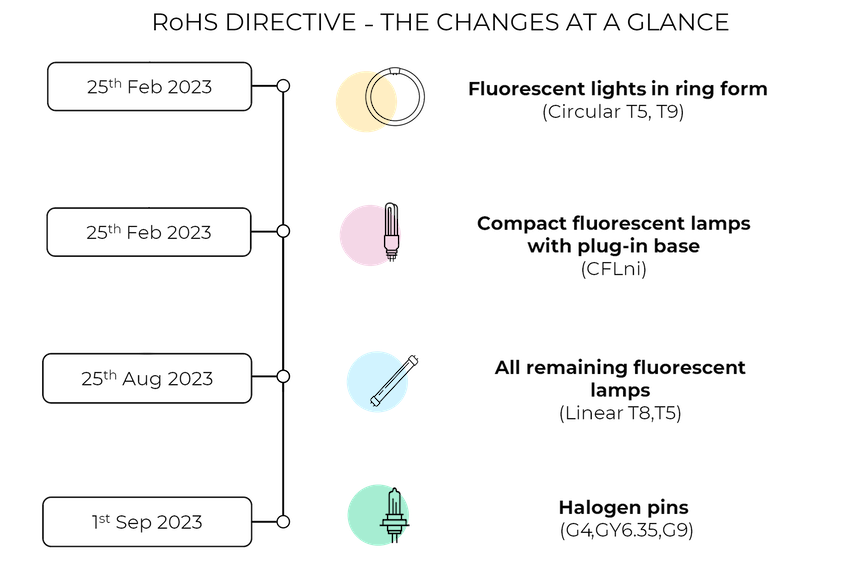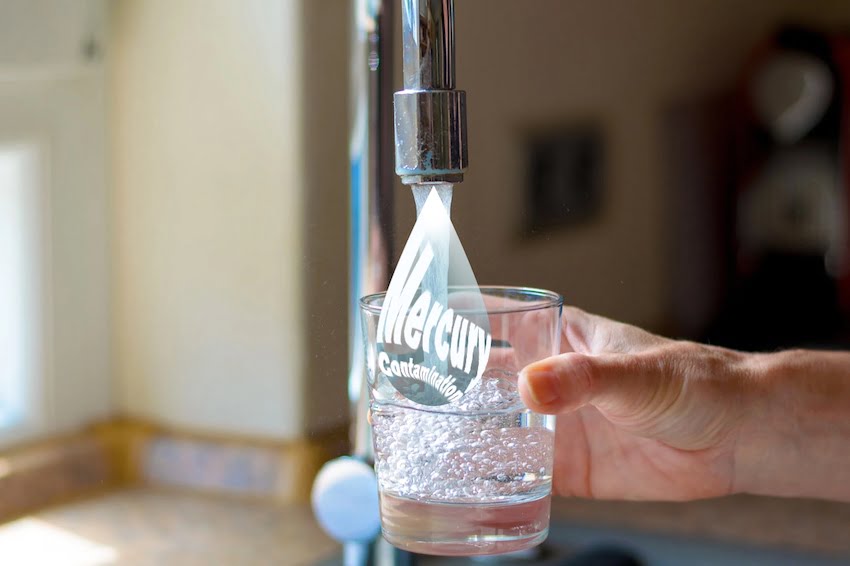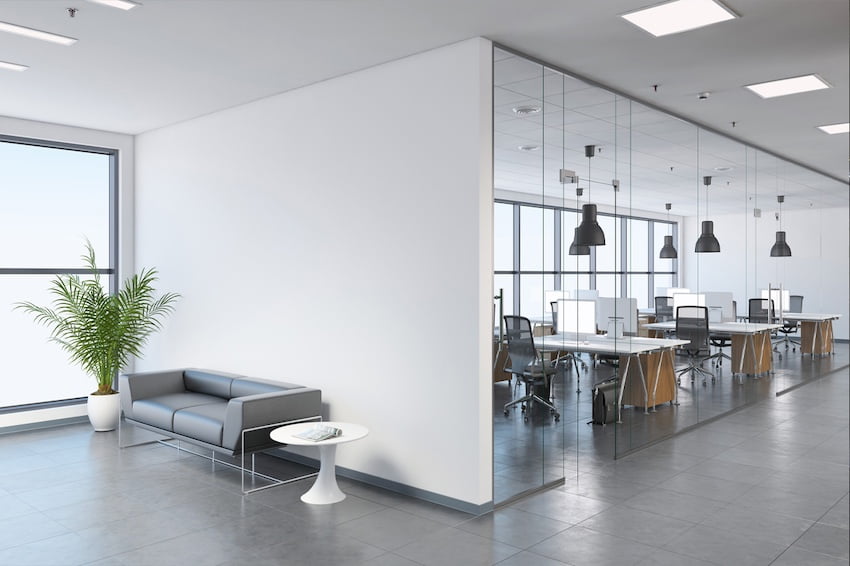On March 13, 2022, the Restriction of Hazardous Substances (RoHS) Directive underwent 12 revisions. This included phasing out certain inefficient fluorescent light fittings. Additionally, exemptions for the use of mercury in light fittings were removed.
Some older types have already been removed from the market. Businesses and domestic consumers alike will see most non-LED lights disappear from the market in 2023. Some are phased out sooner than originally planned.
Need help upgrading your lighting?
The changes to the RoHS Directive brought the phasing out of certain types of lamps and light fixtures forward.
From February 25, 2023, certain types of fluorescent lamps will be prohibited from entering the market. These include circular T5 fluorescent lamps and compact fluorescent lamps with plug-in bases (CFLni).
Starting on August 25th, 2023, linear T5 and T8 fluorescent lamps begin to be phased out.

Manufacturers are not allowed to place non-compliant light fittings on the market from specified dates. Existing stock and use will still be permitted.
1st September 2018:
1st October 2021:
25th February 2023:
25th August 2023
1st September 2023
Traditional light fixtures, such as incandescent, halogen, and fluorescent, are no longer suitable. They are highly energy-inefficient and have a negative environmental impact.
• Tackling climate change: achieving net zero
• Removing hazardous substances: mercury
The UK and EU have pledged achieve net zero by 2050. Department for Business, Energy & Industrial Strategy (BEIS) reports that lighting uses roughly 20% of the electricity produced in the UK. In certain commercial and industrial buildings, such as offices and schools, this figure can be as high as 50%.
However, many lighting systems waste up to 90% of energy and generate unnecessary carbon emissions.

Halogen bulbs are highly inefficient. They also have a short lifespan. Fluorescent lighting is more efficient than halogen. However, it still produces heat and contains mercury which poses risks to humans, wildlife, and the environment.
The UK follows the RoHS Directive. This directive promotes the transition to energy efficient LED lighting. This transition is part of the UN Minamata Convention on Mercury. Mercury is a top public health concern due to its neurotoxic effects and harm to the environment.
Mercury is a neurotoxic chemical element used in industrial processes and various products, including light fittings. When it is released into the environment, it enters the food chain and can bio-accumulate in fish. Exposure to high levels of mercury can cause harm to the brain, lungs, kidneys, and immune system.

Currently, over half of the lamps and light fittings that contain mercury are not disposed of properly. Banning mercury in lighting is a critical step towards making our environment and food chain safer.
Do you want your lighting to be safe, environmentally friendly and start saving you on costs?
Fluorescent T5 and T8 light fittings are commonly used in commercial and industrial buildings like offices, schools, and hospitals. The fluorescent ban means that these lamps and tubes will no longer be available in the market. They will only be available until stock runs out.
Businesses and domestic users can keep using their current fluorescent tubes and lamps. However, this type of lighting is not sustainable or energy efficient, and it poses a biohazard.
The phasing out of fluorescent T8 and T5 lighting has come at a time when most UK businesses are already dealing with high energy costs. An energy-efficient lighting upgrade would be a practical solution for reducing costs and achieving sustainability.

Many businesses or facilities teams do not have a strategic approach to their lighting. As LEDs provide a better-quality lighting experience and improved efficiency, these often get retrofitted on a failure basis.
However, there several reasons why businesses and FM companies should look at their lighting upgrade from a more strategic POV:
While fluorescent lights last for about 10,000 hours, LEDs can last for up to 100,000 hours or more. LEDs do not have a filament that can burn out. This reduces wear and tear on the components, as they generate less heat.
LEDs can have a significantly longer lifespan when controlled by intelligent controls. This optimises and reduces the light output of the fittings.
Replacing failing lights on a case-by-case basis can be costly, resulting in more waste and higher maintenance costs. A well-planned retrofit is a better option. A good quality and intelligent LED lighting system can last over 20 years minimising maintenance costs.
When businesses replace equipment, they may be tempted to choose equipment with the lowest capital cost. However, this short-term cost-saving measure may prove to be a false economy. Choosing higher energy-efficient products can reduce life cycle costs, resulting in improved cash flow in the long term.
LEDs are an excellent option for reducing carbon emissions and saving energy bills over time. However, without high-quality intelligent controls, LEDs cannot deliver the desired savings.
On average, LEDs can reduce energy consumption by 50% compared to older lights. Intelligent lighting controls added to LEDs can save an additional 70-85% of energy. Overall, this can result in a 90% energy reduction compared to traditional lighting.
Over the lifecycle of an energy-efficient and intelligent lighting system, the additional savings from controls make a strong business case.
Replacing traditional lighting with LED (without smart controls) when energy prices were 16p per kWh would have saved money on energy at the time. But with energy prices more than double, these savings would have already diminished.
Doing the right thing for the climate – has never made more sense for the bottom line.
Lastly, ensuring quality and compliance is essential. Older lighting systems were not designed with energy efficiency in mind. This has resulted in areas with inadequate or excessive lighting levels, as well as non-compliant emergency lighting.
At CILS, we take pride in our expertise in implementing intelligent commercial lighting systems. We redesign the existing lighting to be as energy efficient as possible, perfect for the task at hand, and compliant with the latest industry guidelines supplied by CIBSE.
Via advanced intelligent controls emergency lighting testing and reporting can also be automated for further costs and time savings.
Overall, upgrading to LED lighting with intelligent controls is a strategic approach that provides long-lasting benefits for businesses. These benefits include cost savings, energy efficiency, and compliance with industry standards.
CILS have the expertise to help you navigate the complex process of upgrading your lighting. We provide complete lighting (and solar PV) solutions to maximise your business energy savings.
We offer both Capex and zero-capital options that can deliver cash flow positive results immediately. Contact us to start saving immediately.